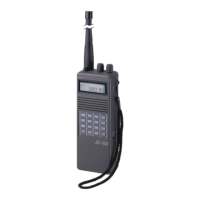
Do you have a question about the Sporty's Air-Scan JD-100 and is the answer not in the manual?
| Channels | 200 |
|---|---|
| Type | Handheld Scanner |
| Frequency Steps | 5 kHz |
| Power Source | 4 AA batteries or external DC power |
| Features | Backlit LCD Display |
Provides an overview of the manual's content and scope.
Lists the key capabilities and specifications of the JD-100 scanner/receiver.
Details the terms and conditions of the product's limited warranty.
Warns against servicing the unit oneself and advises referring to qualified personnel.
Instructs to remove power and seek qualified inspection after liquid spills or object entry.
Advises against disposing of batteries in fire due to explosion risk.
Stresses using only approved external power adapters specified in the manual.
Warns against placing the receiver near heat, moisture, dust, or shock.
Recommends using a soft cloth with mild detergent for cleaning, avoiding abrasive cleaners.
Explains LCD behavior at extreme temperatures and recommends staying within the operating range.
Identifies Antenna Connector and Earphone Jack on the top of the JD-100.
Details Screen, Speaker, Keypad, and operational keys on the front of the JD-100.
Identifies Wrist Strap Pin and External Power Jack on the side of the JD-100.
Describes the Removable Battery Cover on the rear of the JD-100.
Explains how frequencies are displayed on the screen, including decimal place handling.
Details the process of manually entering a desired frequency using the keypad.
Explains how to manually scan frequencies using Up/Down keys.
Describes initiating an automatic search for broadcasting signals.
Details how the scanner stops on signals, resumes, and wraps around frequency ranges.
Explains how to cancel or reverse the search direction.
Introduces the 20 memory channels, including the priority channel and its features.
Guides on how to store a selected frequency into a memory channel.
Explains overwriting existing channels or selecting others before storing.
Explains how to retrieve stored frequencies from memory channels.
Details methods for scrolling or entering specific memory channel numbers.
Describes how the recall function stays active until cleared and allowed inputs.
Explains how to start scanning stored memory channels.
Covers how the scan stops on signals, resumes, and can be cancelled or reversed.
Guides on how to erase a specific memory channel's stored frequency.
Explains the procedure for clearing all memory channels at once.
Describes how to lock the keypad to prevent accidental input.
Explains how to unlock the keypad.
Explains the "BATT" display and flashing frequency for low batteries.
Details how to turn the screen backlight on and off.
Explains how to activate or deactivate the audible key press tone.
Lists optional power adapters for external power supply.
Describes the Cordura carrying case and metal belt clip.
Lists optional antennas, including Rooftop, Magnetic Base, and VHF Aircraft/Car kits.
Specifies the VHF and UHF frequency ranges the JD-100 can receive.
States the total number of memory channels available (P to 19).
Details weight and dimensions (height, width, depth) of the unit.
Outlines the recommended operating temperature range and frequency stability.
Lists internal battery and external power supply requirements.
Details audio output, channel rejection, sensitivity, selectivity, bandwidth, and power consumption.